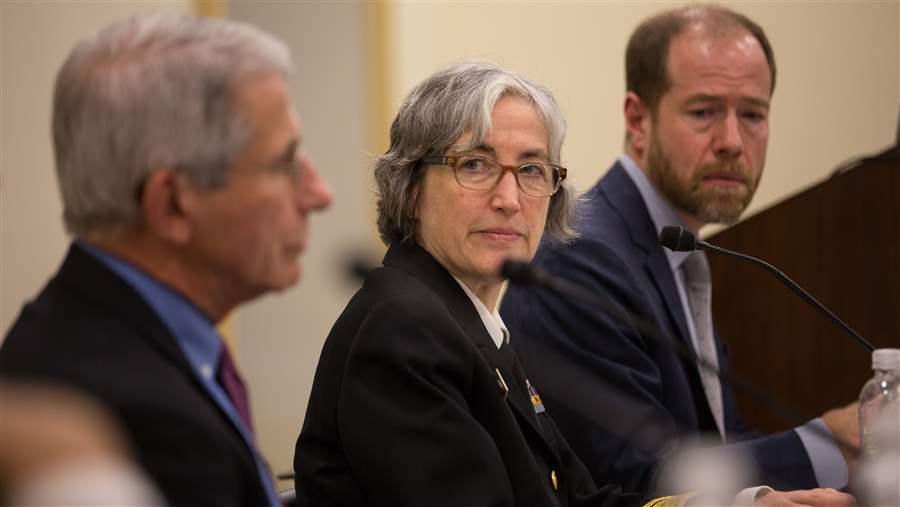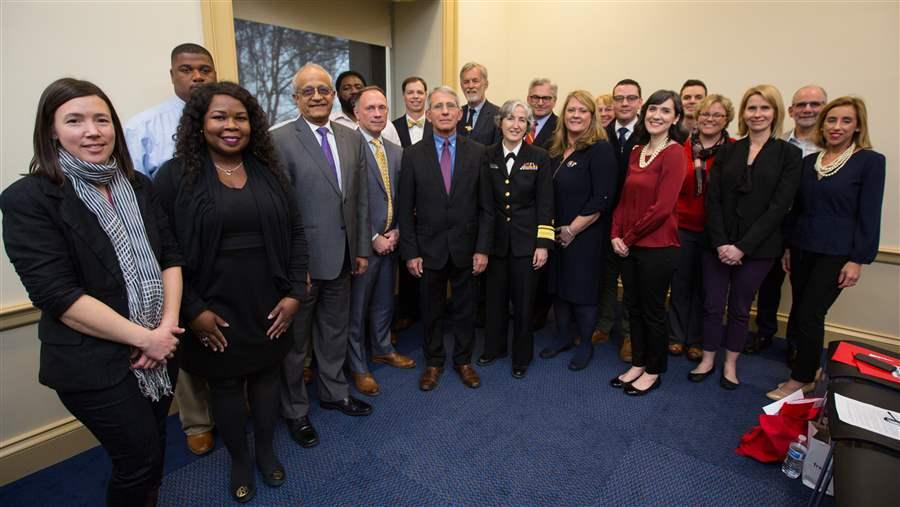How CDC Is Combating Antibiotic-Resistant Bacteria
A look at the agency’s efforts to fight superbugs

The CDC’s Dr. Anne Schuchat at a Capitol Hill briefing on “Innovation and the Fight Against Superbugs” on March 1. The event was co-hosted by The Pew Charitable Trusts and the Infectious Diseases Society of America.
The Pew Charitable TrustsAnne Schuchat, M.D., is principal deputy director of the Centers for Disease Control and Prevention. She spoke at length with Pew about the threat of antibiotic resistance and what CDC is doing to combat it.
Q: What do people mean when they talk about a looming post-antibiotic era? Is that a real possibility?
A: Antibiotic resistance puts all of the progress we have made—in improving public health and quality of life, in combating infectious disease, and in modernizing health care—at risk. The threat of antibiotic resistance is like a time machine that takes us back to when simple infections were deadly.
For a growing number of people, the post-antibiotic era has already arrived. We now live in a time when each year at least 23,000 Americans die from untreatable infections. Antibiotic-resistant infections are difficult to treat and require extended hospital stays and additional follow-up doctors’ visits. They can result in greater disability and death compared with infections that are able to be treated with antibiotics.
Q: Why is CDC working to improve the way antibiotics are used in the U.S.?
A: When used correctly, antibiotics are lifesaving medicines that fight bacterial infections. Antibiotic misuse—for example, taking the drugs unnecessarily, taking the wrong antibiotic, or not taking them exactly as prescribed—creates fertile ground for the growth of antibiotic resistance.
We take antibiotics for granted at our own peril. We assume they will always be available and effective, when the truth is that deadly bacteria are becoming immune to existing antibiotics faster than we can find new ones.
At least 80 million antibiotic prescriptions written each year in the United States are unnecessary, which makes improving antibiotic prescribing and use a national priority.
Q: How does CDC work with other federal agencies, state and local public health departments, and other stakeholders to combat antibiotic-resistant (AR) bacteria?
A: CDC collaborates with a variety of human and animal health experts to fight antibiotic resistance and to implement the National Action Plan for Combating Antibiotic-Resistant Bacteria. Our partners include health care providers and administrators, veterinarians and farmers, leaders in diagnostics and pharmaceuticals, agriculture and environmental specialists, policymakers and representatives from other federal agencies, and many more.
We are working in every state in the U.S. and many countries of the world to defend against antibiotic resistance by supporting local efforts. Over 170 examples of how federal funding helped at the local level are included in CDC’s AR Investment Map, a web app providing details about CDC funding for each state and many large cities.
Q: Can you give an example of how federal funding helps this work on a local level?
A: In Tennessee, a person got a rare infection with the “nightmare bacteria” NDM-producing CRE, which is extremely resistant to antibiotics. It might have meant a major outbreak throughout the facility caring for the patient. But the facility and state Health Department immediately began CDC’s containment protocol and isolated the patient. There were no additional cases.
CDC supports most of these activities through its Antibiotic Resistance Solutions Initiative. Since 2016, CDC’s AR Solutions Initiative has supported comprehensive antibiotic resistance work nationwide. CDC has provided $144 million to 50 states, six large cities, and Puerto Rico to address this threat. CDC also invested more than $76 million in universities and health care partners to find and implement innovative ways to prevent resistant infections and contain their spread. CDC collaborated with more than 60 institutions on applied public health research projects.
And, of course, we work with other federal agencies such as the Centers for Medicare & Medicaid Services, National Institutes of Health, the Food and Drug Administration, the Department of Defense, and the Veterans Administration.
Q: What is something CDC is doing in the fight against superbugs that most people might not know about or is particularly innovative?
A: An example of something that CDC is doing that people may not know about, but is especially exciting, is the CDC and FDA AR Isolate Bank, launched in 2015. The AR Isolate Bank is a collection of disease-causing bacteria carrying known or emerging resistance mechanisms representing samples from health care-associated, foodborne, sexually transmitted, and community-associated infections.
CDC collects samples of bacteria and fungi from health departments, labs, and outbreak and surveillance activities for the AR Isolate Bank, and makes both the isolate and its resistance data available to scientists working on ways to fight antibiotic resistance. Often, CDC uses whole genome sequencing to determine the isolate’s DNA fingerprint.
Q: Over the past several years, Pew and CDC have been collaborating on research to better understand how antibiotics are used in the U.S. Why is it important to quantify antibiotic use that is unnecessary and inappropriate?
A: Antibiotics are critical treatments for many common infections, such as pneumonia, and for life-threatening conditions like sepsis. They are used when their benefits are judged to outweigh their side effects—which can include rash, dizziness, nausea, diarrhea, and yeast infections. More serious side effects include life-threatening allergic reactions and Clostridium difficile infection (better known as C. diff), which causes severe diarrhea and can lead to serious colon damage and death.
And the biggest side effect of antibiotic use on a societal level is that it offers a survival advantage to bacteria carrying and spreading resistance genes. Improving the way health care providers prescribe— and the way we take—antibiotics helps to keep us healthy now, helps fight antibiotic resistance, and ensures that lifesaving antibiotics will be available for future generations.
In 2016, CDC collaborated with The Pew Charitable Trusts and other public health and medical experts on a study published in the Journal of the American Medical Association which found that at least 30 percent of antibiotics prescribed in outpatient settings in the United States are unnecessary.
Pew has been a critical convener, bringing leaders in the field together from related industries to find solutions to the threat of antibiotic resistance.
Q: CDC has been a longtime leader in combating antibiotic-resistant bacteria. Can you tell us a little bit about why CDC continues to make antibiotic resistance a priority and how CDC plans to fight superbugs in the years ahead?
A: As a nation, we are positioned for a better and faster response to antibiotic resistance because of CDC’s investments in all 50 states. These investments support ongoing work that will prevent infections and fight superbugs in the years ahead. In the area of detection and response capacity, we are starting to turn the corner but we have to keep our momentum going.
This complements other effective CDC strategies to prevent all infections through tactics like vaccines, reducing health care-associated infections, plus improving antibiotic use.
Q: What other approaches are you using?
A: Ramping up CDC’s containment strategy is definitely on the near horizon. In the longer term, CDC is piloting several innovations to address the growing AR crisis:
- We are using (and developing) innovative technology to detect new AR threats, respond to outbreaks, and determine the connection between people, animals, and bacteria in the environment.
- Alongside academic investigators, CDC is working to:
- Expand treatment options.
- Discover and pilot new ways to protect patients.
- Guide clinical practice and maximize public health impact.
- Learn more about the role of the microbiome—the microbial world living inside each of us—in preventing infections.
Germs’ ability to fight off the drugs designed to kill them will continue to evolve. We must be sure our strategies and solutions evolve and expand as well. Being innovative and searching for currently unknown answers will be critical to our success.
Q: The administration just released the progress report for the National Action Plan for Combating Antibiotic-Resistant Bacteria. What still remains to be done that you think CDC needs to tackle next?
A: CDC embraces the ambitious goals of the National Action Plan for Combating Antibiotic-Resistant Bacteria.
The national action plan and the subsequent funding by Congress have made a true difference. If we can sustain action and funding on AR, the action plan could be the pivotal turning point in how our country responds to antibiotic resistance.
This is one of the reasons CDC is focusing domestically on our containment strategy: an aggressive approach to stop the spread of emerging microbial threats, including those that may be related to travel. The containment strategy calls for rapid identification of resistant infections, infection control assessments, colonization screenings to stop spread from asymptomatic carriers, a coordinated response between affected facilities, and continued infection control assessments and screenings until spread is controlled.
Q: What gives you hope and inspires you and your colleagues at CDC to keep up the fight in the midst of constantly emerging new superbugs?
A: I have hope because in my time at CDC, I’ve seen firsthand the difference that we can make by leveraging science and service to save lives. We learn more about antibiotic resistance every day, and we are using that knowledge to help our state partners. Investments in CDC’s AR Solutions Initiative already offer successes to build upon, such as:
- Michigan reduced “nightmare bacteria” CRE by 30 percent in 40 facilities and prevented more than 300 infections through its surveillance and prevention initiative.
- 38 states and two cities now use whole genome sequencing to monitor outbreaks and nationwide resistance trends for several common bacterial infections. When foodborne outbreaks occur, local CDC-supported epidemiologists help stop them.
- In Kentucky, an aggressive and coordinated response to a rare and concerning resistance gene (VIM CRE) successfully contained the outbreak and stopped its spread.
- California increased its local response capacity to combat resistant gonorrhea and increased its rapid susceptibility testing by eightfold. (Susceptibility testing shows how well a gonorrhea strain will respond to specific antibiotics.) These results are used to inform local outbreak response action, national treatment guidelines, and antibiotic resistance trends.
Q: How does CDC work internationally to combat AR?
A: Progress at home will be lost if we don’t address antibiotic resistance globally. We do not want to be in a position where we win our battle but lose the war.
It is critical for CDC to work on AR internationally through CDC’s AR Solutions Initiative and the Global Health Security Agenda. Both of these initiatives are working towards a global response that protects Americans from antibiotic resistance wherever it develops.
High levels of antimicrobial-resistant bacteria have been found in all regions of the world and in multiple sectors, including health care, the food supply, and the community. CDC is joining forces with world leaders, nongovernmental organizations, private industry, and public health organizations to develop solutions to combat this urgent and growing threat.
CDC strives to continue to build on the momentum of our global commitment and work in addressing antimicrobial resistance. To support the national action plan and the Global Health Security Agenda, CDC is working to improve international collaboration and capacities for surveillance, infection control, prevention, stewardship, and public health research.
Additionally, CDC works with members from the Transatlantic Taskforce for Antimicrobial Resistance and the World Health Organization to develop a portal for rapid global communication of antibiotic resistance findings that need international attention.
We need to work internationally to protect Americans at home. As we never tire of saying: In today’s world, a health threat anywhere is a health threat everywhere.

Schuchat (center), before the briefing, with panelists from the National Institute of Allergy and Infectious Diseases, U.S. Department of Agriculture, and the Biomedical Advanced Research and Development Authority, as well as advocates from Pew’s Supermoms Against Superbugs initiative.
The Pew Charitable Trusts











